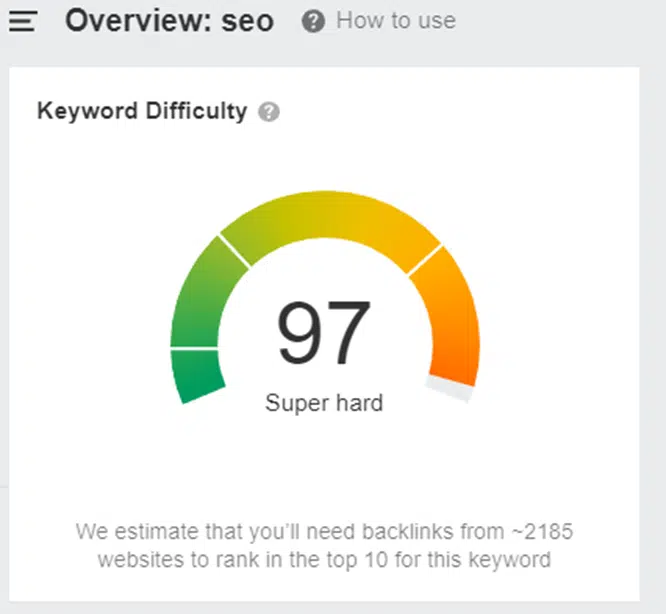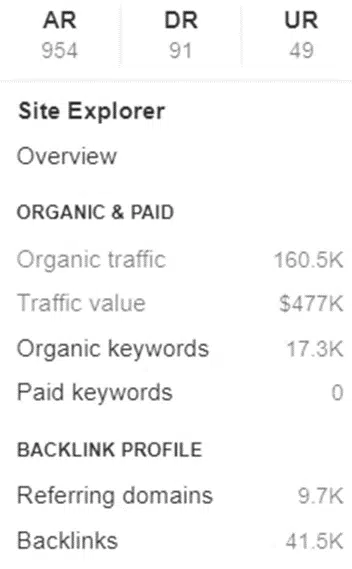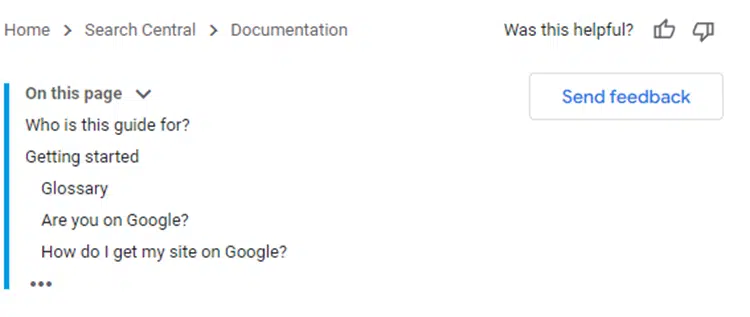How to analyze Google’s SERPs
Conducting SERP analysis will help you understand what is and isn't working for a particular keyword. Here are tips and tools to get started.
SEO has a lot of moving parts.
You have to worry about your content strategy, keyword selection, Google ranking signals, backlinks, and competition.
When clients ask me if they can rank their site for a particular keyword, I conduct a SERP analysis immediately.
I wouldn’t know how difficult it is to rank for a specific keyword without analyzing Google’s SERPs first.
If you’re not conducting base analysis, you might set your site up for failure by funneling all of your resources to a main keyword that is too far out of reach.
Defining SERP analysis
So, what is SERP analysis?
Search engine results page (SERP) analysis is the practice of analyzing the top-ranking pages for your desired keyword, spotting opportunities to rank for this keyword and trying to pinpoint difficulties in reaching the top of the search results.
A SERP analysis demands that you:
- Search for the desired keyword.
- Evaluate the top sites.
- Determine if the keyword is relevant to your site.
- Determine how you “could” rank for this keyword.
However, the final item on this list has a big question mark next to it.
You need to go beyond what you would need to do to rank today because your competitors are working diligently to maintain these rankings in most cases.
How to analyze a Google SERP
Learning how to analyze Google SERPs provides insights into a keyword and your ability to rank for the term. However, you’ll also uncover:
- Additional keywords that you may try to rank for on search engines.
- Opportunities that your competitors are missing.
- Content ideas.
- And more.
You can look through the SERPs manually, but when it comes to competitive keywords, you’ll want a tool to help you with looking at a page’s link profile, number of external backlinks and other factors.
A few tools work very well for this purpose, such as:
- Semrush
- Ahrefs
- Moz
Plug in your keyword to these tools, and you’ll find a wealth of information on the top-ranking pages. For example, on Ahrefs, I just conducted a search for “SEO” and came out with the following:

Search Engine Land’s What is SEO is ranked #2 and shows the following statistics:

Ranking for this keyword will be extremely difficult without a massive budget, a highly reputable website and a backlink campaign.
However, it’s important to look at other factors in a SERP analysis, such as:
- Search intent.
- Type of content ranking.
- The competition.
Search intent
When searching for your query, search intent can be determined by the different layouts and types of pages that you land on. You can tell the intent because it will be one of the following:
- Commercial: Users who are researching before making a purchasing decision.
- Informational: Users who are trying to find a solution to their problem and are educating themselves.
- Navigational: Users who are looking for a brand or website that they already know about.
- Transactional: Users who want to buy a product or service.
Considering these four categories of intent, you’ll find that the keyword “SEO” has informational intent, as all the top results aim to educate their readers. Your goal to outrank these competitors would be to educate the user.
Sites may look something like this:


If you changed the keyword to “books on SEO,” you would find Amazon as a transactional intent keyword because the site is laid out for products.
However, if you changed the keyword to “SEO books on Amazon,” this would be seen as a navigational keyword because the user is looking for these books specifically on Amazon.
Search intent is important because it will dictate your site’s:
- Layout.
- Navigation.
- Personalization.
- Common devices used to access the site.
Once you go through search intent, you can focus on the technical aspects of the site, UI/UX design and content.
Type of content ranking
Often, you’ll find an array of content ranking for a certain keyword. Going back to the “books on SEO” keyword, there are a lot of content types that are ranking:
- Ecommerce stores.
- Listicles.
- Guides.
- Book reviews.
This keyword is far easier to rank for than just “SEO” and you can create the above types of content to meet the needs of people querying this keyword.
When you perform SERP analysis, you have the opportunity to learn what content currently works for your competitors and don’t need to reinvent the wheel. Perhaps you can create a video guide on the top books to go along with your listicle or review article.
Now, you can learn a lot of information from just a few minutes of SERP analysis:
- Keyword difficulty.
- Backlink profile.
- Search intent.
- Content ideas or types to use.
You might even find videos ranking for a certain keyword, allowing you to target traffic via YouTube. It may be easier to show up at the top of the results in a snippet or video than with informational content.
Make a note of SERP features on the page that you may be able to leverage in your content creation, such as:
- Ratings.
- Shopping results.
- People also ask.
- Featured snippet.
- Images.
You can target the keyword from all angles to try and generate traffic from all sources.
The competition
You’ve already done a basic analysis of the top-ranking sites, but now it’s time to look into these sites further. You can look at things such as:
- Keyword difficulty.
- External backlinks to the entire domain.
- External backlinks to the page.
- Domain authority/page authority (or similar).
- Top domain presence.
- Social signals.
It is worth taking the time to look through the competing page and learn about the type of content created, length, proper on-page optimization, formatting, images and video use.
When you analyze competing sites, you can get an idea of what works and how well the site has targeted the keyword.
You may find opportunities to create better content or use on-page and technical SEO to improve your odds of ranking for the keyword.
Additionally, you can identify content gaps in the competitor’s content strategy that may improve your odds of ranking for the keyword.
However, if the entire top page is filled with truly tough competitors, it may be worth finding a new keyword to target.
For example, if the top results include Google’s own sites, Microsoft, Apple and Wikipedia, it will be very difficult to overcome them.
Use your SERP analysis in your SEO and content strategy
Can you rank for the specific keyword within budget and in a relatively timely manner? If so, you can begin to dig deeper by:
- Creating content that is more in-depth and better than your competitors.
- Focusing heavily on the content gaps that the competition is overlooking.
- Improving your on-page and technical SEO.
- Looking through the backlink profile of the top-ranked sites and seeing if there is any opportunity to replicate the backlinks.
If the search results include rich snippets for the query, you absolutely should incorporate structured data into your site, too.
Something as simple as a picture of one of the top-ranking books in SEO can bump up your click-through rate dramatically, even if you’re not ranked as high as some of your competitors.
When older pages or sites are ranking in the top 10 results, they often haven’t implemented structured data, opening up a golden opportunity for you to use it on your page.
You can now begin drafting your content ideas and looking for faults in the competition:
- Perhaps all of the books listed on the competitor’s site are 5+ years old. You can create a new list of books that are relevant to the best practices of today.
- You can create multiple forms of content, such as blog posts, videos and images to improve your chances of ranking higher in the results.
Your content must have its own unique selling proposition. When you create content, it’s important to take a step back and ask:
- Why would people like my content better than what already exists?
- Do I provide any unique insights or data?
- Can I improve readability or add custom images?
If you’re focused on creating generic content without original data or insights, you may not achieve the results that you had hoped for. You’ll find that adding something “special” is a selling point for readers and search engines.
You should spend time making your content or pages the “best.”
However, when the search intent is transactional or navigational, it may be hard to make the content the best. In other cases, you can certainly use a strong content strategy to rank for a keyword.
Once you have everything in place and start posting your content and working on off-page SEO, it’s important to track your keyword rankings.
Many of the tools listed previously offer keyword rank tracking and will allow you to:
- Monitor the keyword over time
- See when you begin improving your ranking for a specific word
- Discover when your rankings drop
Performance monitoring will help you understand what is and isn’t working for your site or a particular keyword.
You may find that you need to conduct another SERP analysis in a few months to see what changes have occurred and how you need to adjust your optimization strategy to see results.
Contributing authors are invited to create content for Search Engine Land and are chosen for their expertise and contribution to the search community. Our contributors work under the oversight of the editorial staff and contributions are checked for quality and relevance to our readers. The opinions they express are their own.
Related stories
New on Search Engine Land